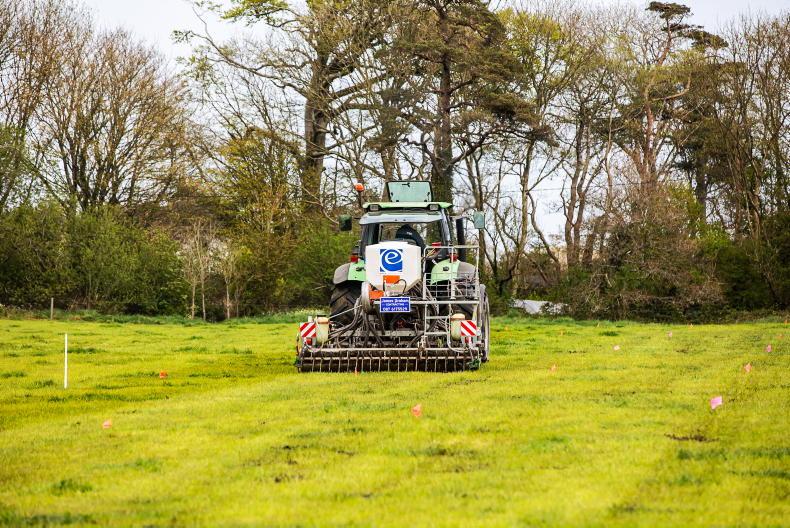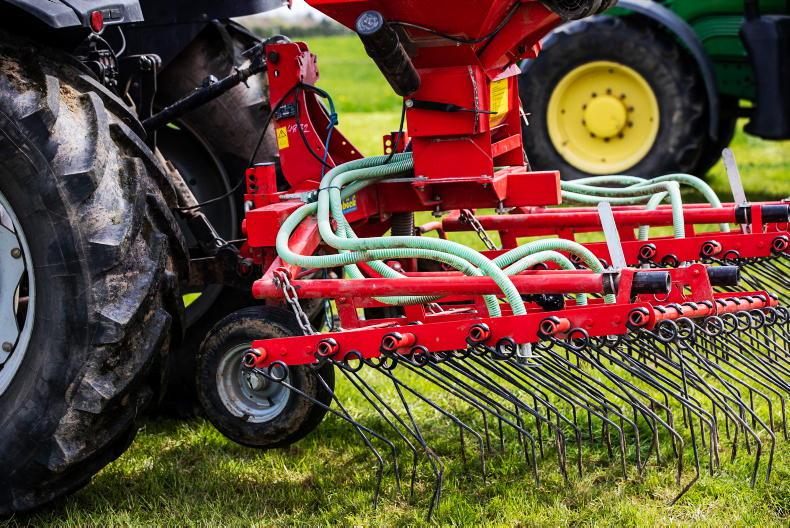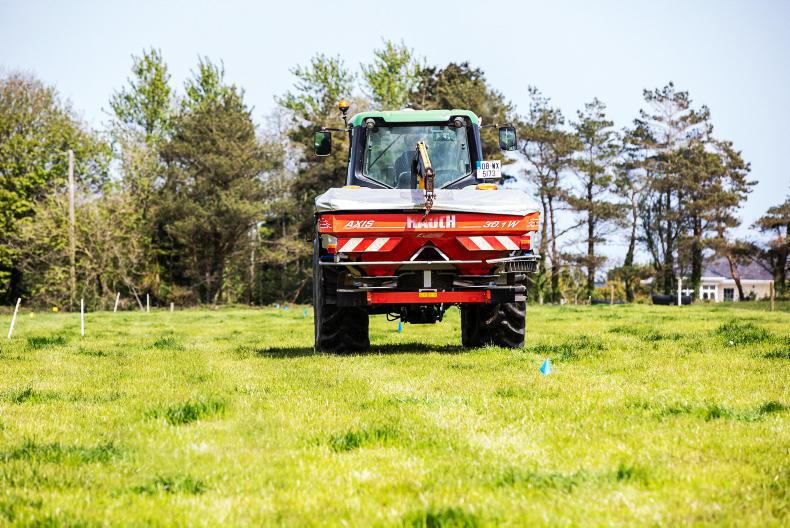Grazing land can be divided up into three categories: grass-only, established clover and fields that clover is being established in. Each should be treated differently and the time to start this different treatment is now.
Last year, many farmers took the opportunity with high nitrogen prices to get clover established either through oversowing or in a full reseed. Twelve months on, it will be apparent now whether that was a success or not.
Where clover was successfully established, the payback should come this summer, provided that the field is managed correctly.
Established clover
Fields with good clover contents, with 20% or more of the sward being clover, are a huge asset to have on any farm.
If there is clover under every footstep as you walk across a field, then that indicates there is 20% or more clover in the sward and that the field can be managed as a high-clover field.
These fields need significantly less applied nitrogen from now on.
The Teagasc advice is to apply around seven units of nitrogen/ac (9kg N/ha) after each grazing during May, June, July and August, followed by 14 units/ac (18kg N/ha) in September.
These are low rates of nitrogen and as such, some farmers decide not to apply any nitrogen on the high-clover fields, while others skip a round and apply 14 units/ac after every second grazing.
Either way, there should be no more than 58 units/ac of nitrogen (72kg N/ha) applied on these established clover swards between now and the rest of the year, even on dairy farms with a high demand for grass.
These swards are high quality, with highly digestible material, so they should be targeted for grazing as much as possible to maximise milk output.

Field with 22% clover content.
If fields are to be closed for silage, aim to close up grass-only swards.
While these clover fields require much less applied nitrogen, they may still require phosphorus, potash, sulphur and lime, so don’t forget to apply these nutrients. The risk of bloat is highest from August onwards, but needs to be monitored all summer.
Establishing clover
The best time to establish clover is in April and May. Clover is an easy plant to germinate, with a high strike rate.
The challenge is to keep these seedlings alive, especially in an established grass sward.
A lack of light is the biggest killer of these seedlings, so grazing the existing sward at regular intervals and at light covers will help to ensure there is light down to the seedlings.
Aim to graze these paddocks at a cover of 800kg to 1,000kg, which means skipping out of the normal rotation to enter these paddocks.
Applying little to no nitrogen to these paddocks for a few months after sowing clover helps to reduce grass growth, thereby giving the clover an extra chance to get established.
This will reduce overall pasture growth on these paddocks, because the clover will not be contributing either feed or nitrogen until next year. This reduced growth rate needs to be factored into feed plans and grass budgets.
Typically, these fields grow 25% to 30% less grass over the summer, and farmers often say they look hungry and starved of nitrogen. However, provided that the fields are grazed at the correct covers, applying nitrogen won’t actually harm the clover seeds.

Slot seeder for oversowing clover into established grassland.
Good soil fertility and high pH is an essential requirement for clover establishment. Even where soil fertility is good, some additional phosphorus may be required at sowing stage because seedlings need phosphorus for root development.
Fields that have some but not enough clover content can be managed in a similar way as above to improve clover content without having to oversow.
Regular grazings at light cover will promote stolon growth and increase clover content.
Grass-only
Grass-only fields or fields with insufficient clover contents to make a contribution will need between 0.8 and 1 unit of nitrogen per ac/day for the summer months.
So, if on a 21-day rotation length, between 17 and 21 units/ac of nitrogen should be spread after grazing to maximise grass growth.
Spreading any more than this is unnecessary for grass growth and increases the risk of nitrogen loss through urine patches and leaching.
Lower-stocked farms and those with a lower demand for grass can get away with lower rates of nitrogen during the summer.
Oversowing methods
Widespread heavy rain this week has put clover to the back of most farmers’ minds – particularly those on heavy soils who are struggling to avoid damage. However, this type of weather is actually ideal for clover establishment.
There are two options for oversowing; broadcasting or sowing with a drill.

Tine harrow seed drill for oversowing clover.
Anecdotal evidence would suggest that drilling is more successful in the sense that seed-to-soil contact is ensured when a suitable seed drill is used, but seed-to-soil contact can also be ensured when clover is broadcast – either through rolling or applying soiled water with a splashplate after spreading seed.
Broadcasting is cheap but can be laboursome, especially when there are larger acreages to be covered.
The clover seed should be measured out at 2kg to 2.5kg and mixed with fertiliser or granulated lime on an acre-by-acre basis in the field, to avoid the clover settling in the spreader.

Broadcasting clover seed with the fertiliser spreader. \ Philip Doyle
The fertiliser should be applied at close bout widths, at a rate of one bag/ac.
Avoid doing any more than two paddocks/year, because any more than this will make it difficult to manage grazing at the correct covers.
Grazing land can be divided up into three categories: grass-only, established clover and fields that clover is being established in. Each should be treated differently and the time to start this different treatment is now.
Last year, many farmers took the opportunity with high nitrogen prices to get clover established either through oversowing or in a full reseed. Twelve months on, it will be apparent now whether that was a success or not.
Where clover was successfully established, the payback should come this summer, provided that the field is managed correctly.
Established clover
Fields with good clover contents, with 20% or more of the sward being clover, are a huge asset to have on any farm.
If there is clover under every footstep as you walk across a field, then that indicates there is 20% or more clover in the sward and that the field can be managed as a high-clover field.
These fields need significantly less applied nitrogen from now on.
The Teagasc advice is to apply around seven units of nitrogen/ac (9kg N/ha) after each grazing during May, June, July and August, followed by 14 units/ac (18kg N/ha) in September.
These are low rates of nitrogen and as such, some farmers decide not to apply any nitrogen on the high-clover fields, while others skip a round and apply 14 units/ac after every second grazing.
Either way, there should be no more than 58 units/ac of nitrogen (72kg N/ha) applied on these established clover swards between now and the rest of the year, even on dairy farms with a high demand for grass.
These swards are high quality, with highly digestible material, so they should be targeted for grazing as much as possible to maximise milk output.

Field with 22% clover content.
If fields are to be closed for silage, aim to close up grass-only swards.
While these clover fields require much less applied nitrogen, they may still require phosphorus, potash, sulphur and lime, so don’t forget to apply these nutrients. The risk of bloat is highest from August onwards, but needs to be monitored all summer.
Establishing clover
The best time to establish clover is in April and May. Clover is an easy plant to germinate, with a high strike rate.
The challenge is to keep these seedlings alive, especially in an established grass sward.
A lack of light is the biggest killer of these seedlings, so grazing the existing sward at regular intervals and at light covers will help to ensure there is light down to the seedlings.
Aim to graze these paddocks at a cover of 800kg to 1,000kg, which means skipping out of the normal rotation to enter these paddocks.
Applying little to no nitrogen to these paddocks for a few months after sowing clover helps to reduce grass growth, thereby giving the clover an extra chance to get established.
This will reduce overall pasture growth on these paddocks, because the clover will not be contributing either feed or nitrogen until next year. This reduced growth rate needs to be factored into feed plans and grass budgets.
Typically, these fields grow 25% to 30% less grass over the summer, and farmers often say they look hungry and starved of nitrogen. However, provided that the fields are grazed at the correct covers, applying nitrogen won’t actually harm the clover seeds.

Slot seeder for oversowing clover into established grassland.
Good soil fertility and high pH is an essential requirement for clover establishment. Even where soil fertility is good, some additional phosphorus may be required at sowing stage because seedlings need phosphorus for root development.
Fields that have some but not enough clover content can be managed in a similar way as above to improve clover content without having to oversow.
Regular grazings at light cover will promote stolon growth and increase clover content.
Grass-only
Grass-only fields or fields with insufficient clover contents to make a contribution will need between 0.8 and 1 unit of nitrogen per ac/day for the summer months.
So, if on a 21-day rotation length, between 17 and 21 units/ac of nitrogen should be spread after grazing to maximise grass growth.
Spreading any more than this is unnecessary for grass growth and increases the risk of nitrogen loss through urine patches and leaching.
Lower-stocked farms and those with a lower demand for grass can get away with lower rates of nitrogen during the summer.
Oversowing methods
Widespread heavy rain this week has put clover to the back of most farmers’ minds – particularly those on heavy soils who are struggling to avoid damage. However, this type of weather is actually ideal for clover establishment.
There are two options for oversowing; broadcasting or sowing with a drill.

Tine harrow seed drill for oversowing clover.
Anecdotal evidence would suggest that drilling is more successful in the sense that seed-to-soil contact is ensured when a suitable seed drill is used, but seed-to-soil contact can also be ensured when clover is broadcast – either through rolling or applying soiled water with a splashplate after spreading seed.
Broadcasting is cheap but can be laboursome, especially when there are larger acreages to be covered.
The clover seed should be measured out at 2kg to 2.5kg and mixed with fertiliser or granulated lime on an acre-by-acre basis in the field, to avoid the clover settling in the spreader.

Broadcasting clover seed with the fertiliser spreader. \ Philip Doyle
The fertiliser should be applied at close bout widths, at a rate of one bag/ac.
Avoid doing any more than two paddocks/year, because any more than this will make it difficult to manage grazing at the correct covers.










 This is a subscriber-only article
This is a subscriber-only article










SHARING OPTIONS: